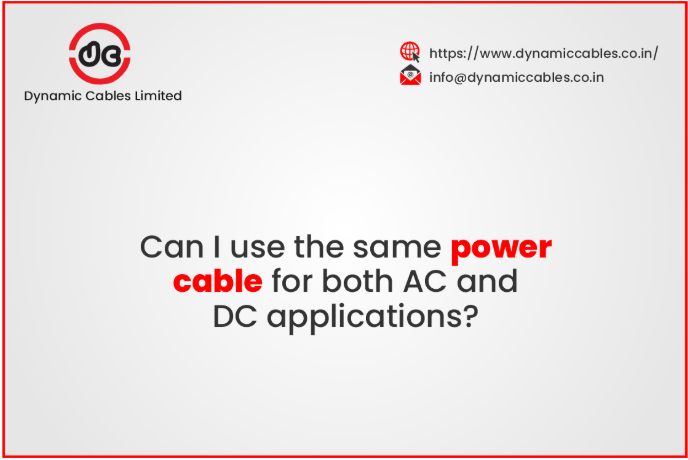- An ISO 9001:2015, 14001:2015 & 45001:2018 Company

Can I use the same power cable for both AC and DC applications
When it comes to electrical wiring, one common question many ask is: Can I use the same power cable for both AC (Alternating Current) and DC (Direct Current) applications? The answer depends on several factors such as cable construction, insulation, voltage requirements, and the environment where the cable is used. In this blog, we'll break down the differences between AC and DC applications and whether the same power cables can work for both. We'll also cover the types of power cables, their features, and common uses of power cables — so you can make the right choice for your needs.
What Are Power Cables?
Power cables are essential components used to carry electricity from one point to another. Whether it's lighting your home or powering an entire factory, power cables play a key role. They consist of conductors (usually copper or aluminium) and are covered with insulating materials like PVC, XLPE, or rubber for safety. Based on their design and material choice, these cables can meet low, medium, or high voltage needs in various settings.
Can the Same Power Cable Be Used for AC and DC?
Yes, in many cases, the same power cable can be used for both AC and DC applications — but with some considerations:
Insulation Material:
DC voltage does not alternate and puts constant stress on the insulation. Cables used for DC should have insulation materials like XLPE or rubber that can handle steady voltage levels.
Conductor Size:
DC systems may require a slightly thicker conductor due to higher energy losses over long distances.
Shielding & Armour:
For both AC and DC, shielding or armoured layers help protect the cable from interference and mechanical damage.
Voltage Rating:
Always ensure the power cable is rated for the specific voltage in your AC or DC system.
If you're unsure, always consult a certified cable supplier, such as Dynamic Cables Limited, to choose the right cable for your project.
Uses of Power Cables
The uses of power cables are broad and span across multiple sectors:
- Residential: Used for wiring lights, fans, and household appliances.
- Commercial: Powering devices in offices, hospitals, and malls.
- Industrial: Running heavy machinery, motors, and automated lines.
- Infrastructure: Carrying electricity through power grids, transformers, and substations.
Features of Power Cables
Selecting the right cable means understanding the key features of power cables:
Conductor Type:
Copper offers superior conductivity and strength, while aluminium offers lighter and more cost-effective construction materials.
Insulation:
XLPE is heat-resistant and perfect for demanding environments. PVC is moisture-resistant and flexible.
Voltage Support:
Choose based on your load requirement—Low Tension (LT) for small systems, High Voltage for industrial setups.
Armour & Shielding:
For extra protection in rough conditions or where there's a lot of electromagnetic interference.
Fire Resistance:
Especially important in public or commercial areas to reduce fire risk.
Environmental Impact on Cable Lifespan
The life and performance of power cables depend a lot on the environment. Factors like moisture, heat, UV exposure, chemicals, and physical stress can cause cables to degrade faster. This ageing can lead to safety hazards or system failures. That's why it's important to choose high-quality cables and make sure they are suited to the conditions they'll be used in.
Why Choose Dynamic Cables Limited?
Dynamic Cables Limited is one of India's top power cable manufacturers. Quality, safety, and durability are at the core of our product offering; therefore, we provide an impressive variety of reliable products.
Here's what makes us different:
- We follow global standards like IS, IEC, and BS
- Use high-quality copper and aluminium for better performance
- Eco-friendly and safe production methods
- Products range from PVC power cables, LT XLPE cables, to 66 KV high voltage cables
- Custom solutions for residential, commercial, or industrial needs
Conclusion
So, can the same power cable be used for both AC and DC applications? The answer is yes, but only if the cable meets the technical and safety requirements of both systems. Selecting the ideal cable requires considering not just power flow but also durability, safety, and long-term reliability. Dynamic Cables Limited expert guidance and high-quality products can help your systems operate seamlessly regardless of whether they utilize AC, DC power, or both.
FAQs
-
Q1. Can I use one power cable for both AC and DC systems?
Yes, a power cable designed to accommodate AC and DC can be used with either. Before making this choice, always ensure the rating of the cable. -
Q2. What should I look for when choosing a power cable?
Look at the cable's voltage rating, conductor material (like copper or aluminium), insulation type (like PVC or XLPE), and whether it has armour for protection. These things help you pick the right cable for your use. -
Q3. Are copper cables better than aluminium for AC or DC?
Yes, copper cables are better for both AC and DC because they carry electricity more easily and last longer. Aluminium is cheaper but may need a larger size for the same job. -
Q4. Where are power cables commonly used?
Power cables are used in homes for wiring, in offices for lights and systems, in factories for machines, and in power plants or grids to carry electricity over long distances. -
Q5. Do outside weather conditions affect power cables?
Yes, weather like heat, rain, sunlight, and chemicals can wear out power cables over time. That's why it's important to choose cables made for the conditions they'll be used in.
 English
English

 C701, Tower-C, Noida One
C701, Tower-C, Noida One
